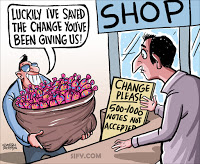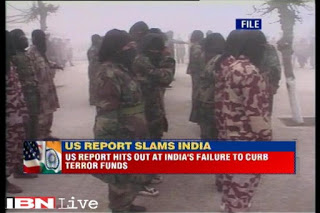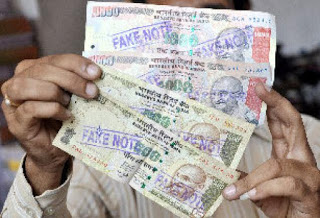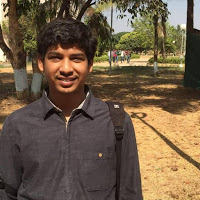
In what is being labelled a Surgical Strike against black money, the government, without the slightest of hints, has demonetised a large portion of the Indian currency. This swift manoeuvre was targeted at a diverse stratum of defaulters, which includes everybody from politicians to the Seth Ji next door. However, this initiative is being lauded primarily for the big gash it would leave on terrorism in India. Eminent people including the Defence Minister has showered heavy praise on this move calling it a strike on the “Core of terror funding.” In this regard, the article aims to study the various modes of terror financing and the effect of the demonetization scheme on them.
Terrorism holds a major stake in the flourishing counterfeiting racket. Reports suggest that Pakistan’s intelligence agency, the ISI, has access to templates of Indian currency. This, along with the fact that India and Pakistan, both, buy the similar ink and silver lining, makes it extremely easy for state and non-state actors across the border to accurately counterfeit Indian currency.

Hordes of fake notes are discharged into the Indian economy, after manufacturing, either by infiltrating insurgents or through the hawala system, which is another important source of income for the terror organisations. This modus operandi came to light through the arrest of many terror operatives, the most famous being David Coleman Headley, the primary scout during the 26/11 attacks on Mumbai. Interrogation revealed that the entire Mumbai expedition was financed through high quality fake notes.Instances like the above and scores others have led investigators to believe, that the primary source of terror financing in India is counterfeiting currency.
Therefore, what the Centre has essentially done with the demonetisation scheme is rob the terrorists of their primary source of funding. In its essence, the initiative renders the huge caches of fake Indian currency with terror outfits, worthless. It leaves insurgents with little to no money to carry out missions or even survive in India.
Secondly, the initiative also tightens the noose around arms dealers and the drug trafficking mafia. India’s gun markets have been the go-to places for terrorist sleeper cells or recruits from within the country to procure weapons. Infamous markets like the Munger gun market in Uttar Pradesh run entirely on black money. From the manufacturers to transporters and the customers, which range from small time criminals to terrorists, everybody with a stake in these underground markets operate on black money. Therefore, demonetisation would lead to the immediate collapse of such markets and create a huge supply gap in the illegal arms trade. It can be concluded that, along with losing sources of income, terrorist now have been left with absolutely no place to stock inventory and buy weapons and explosives to carry out their objectives.
Further, like the arms industry, narcotics dealing also runs on stock piles of black money. Capitalising on this, terrorist organisations profit considerably from transporting opium from Afghanistan and smuggling it into Indian territories, majorly, Rajasthan and Punjab. Like anything that runs on non-taxable money, the drug industry would also collapse days after the implementation of the move. With this, the government can celebrate the delivery of yet another blow to terror financing in the country.
So far, I have commented on the various effects of the demonetisation of notes, with respect to the terror financing in the country. However, I would like to add that despite of various adverse effects the initiative might deal with, it is sadly not a strategy that deals a 360-degree blow. To prove my point further, I have listed a few points that have been overlooked by the policy makers.
Firstly, a major drawback with the design of the new currency is that there are no significant differences from the older notes. The changed graphics, colour and denominations may seem enough to prevent duplicating, but sadly are not. The new notes use ink and lining from the same vendor as before, and, the fact that the security features remain same is concerning. It is only a matter of time that the counterfeiting industry figures out a way to bypass the meagre changes induced by the government. Therefore, it would be justified to say that the policy makers did not opt for a very far sighted approach but stuck to a one that would avail short term results.
To affirm long lasting results, India must make a strong effort directed at the international community to stop the vending of ink and other raw materials, to unofficial buyers. It must also make diplomatic parleys with the government of Pakistan to ensure material doesn’t end up with terror organisations and pressure it to beef up security. Additionally, the international community through the U.N. must be persuaded to pass resolutions that ban and lay down strong deterrent measures to curb counterfeiting of currency. To achieve the deterrent effect internally, a suggested way would be to bring counterfeiting under the anti-terrorism laws of the country and pronounce strict punishments.
Further, though gun markets in India will face the brunt, markets outside the country will be unaffected. It must be noted that a major part of terrorism is carried out by insurgents infiltrating the border. These operatives, seldom carry weapons that originate in India and function solely on weapons manufactured beyond Indian borders and paid for in foreign currency. Hence, the shutting down of indigenous gun markets will prove to be a precision shot for your local don but a mere flesh wound for terrorist organisations. The only way supply to terrorists can be stopped is to physically crack down and put an end to internal gun markets as well as tighten security at the borders to prevent supply from abroad.
To conclude, I would like to reiterate a view opted by many experts, stating that terrorism is like not a single headed demon but multi headed monster. It is a self-sustaining movement that has umpteen ways to finance itself, some of which are listed above. The demonetisation of Rupees 500 and 1000 notes will indeed hinder terror operations in the country, but in my view, only for a short time. Though the Prime Minister’s effort can be lauded, it must be understood that this initiative must be complemented by several more, such as strengthening legislation, surgical strikes and others. It’s high time that terrorism is cornered and initiatives drawn to strike all its heads at once. Hence, the monster shall be slain.
About the Author:
Nazeer if a fifth year law student from the Faculty of Law IFHE. He is an avid reader of war history politics and law. He has high interest for foreign policy and the legality of armed conflict. He is also a staunch pacifist.
 Hordes of fake notes are discharged into the Indian economy, after manufacturing, either by infiltrating insurgents or through the hawala system, which is another important source of income for the terror organisations. This modus operandi came to light through the arrest of many terror operatives, the most famous being David Coleman Headley, the primary scout during the 26/11 attacks on Mumbai. Interrogation revealed that the entire Mumbai expedition was financed through high quality fake notes.Instances like the above and scores others have led investigators to believe, that the primary source of terror financing in India is counterfeiting currency.
Hordes of fake notes are discharged into the Indian economy, after manufacturing, either by infiltrating insurgents or through the hawala system, which is another important source of income for the terror organisations. This modus operandi came to light through the arrest of many terror operatives, the most famous being David Coleman Headley, the primary scout during the 26/11 attacks on Mumbai. Interrogation revealed that the entire Mumbai expedition was financed through high quality fake notes.Instances like the above and scores others have led investigators to believe, that the primary source of terror financing in India is counterfeiting currency. 




![Police Reforms – Priority ignored [Republished from Epilogue Press] Police Reforms – Priority ignored [Republished from Epilogue Press]](https://arguendo.co.in/wp-content/uploads/2017/07/41-150x150.jpg)

Leave a Reply